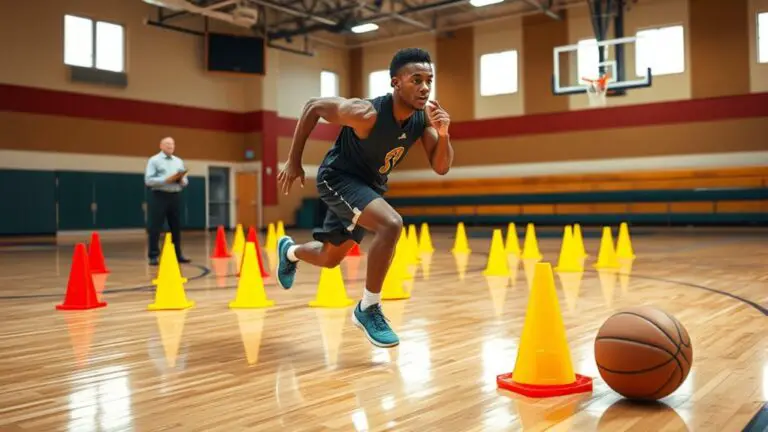How to Improve Athletic Performance Through Gym Training

To improve your athletic performance through gym training, you should focus on strength training to build muscle and enhance functional strength. Design a tailored workout routine that balances workouts and includes recovery days. Incorporate cardiovascular training to boost endurance and heart health. Don’t overlook flexibility and mobility work to prevent injuries. Plus, proper nutrition and hydration play an essential role in recovery and performance. There’s more to explore for a well-rounded approach to your training.
Understanding the Importance of Strength Training

When you consider improving your athletic performance, strength training should be at the forefront of your routine. It’s vital for building muscle hypertrophy, which refers to the increase in muscle size. This not only enhances your appearance but also contributes to better functional strength, allowing you to perform everyday tasks with ease and efficiency.
Incorporating strength training into your regimen helps support your joints and reduces the risk of injury, making it an essential component for safety-minded athletes. By focusing on exercises that promote muscle hypertrophy, you can improve your overall power and endurance, translating to better performance in your chosen sport. Additionally, exercises like the clean and press can engage multiple muscle groups, further enhancing your strength training routine.
Remember to prioritize proper form and technique to maximize benefits while minimizing injury risk. Whether you’re lifting weights or using resistance bands, the goal is to create a balanced routine that fosters both strength and safety. With dedication, you’ll see significant improvements in your athletic capabilities.
Designing a Tailored Workout Routine
To enhance your athletic performance effectively, it’s vital to design a tailored workout routine that aligns with your specific goals and needs. Start with goal setting—whether you aim to build strength, improve endurance, or enhance agility, having clear objectives will guide your routine. Next, consider your training frequency. A balanced approach, typically 3-5 workouts per week, guarantees you’re challenging your body while allowing for recovery. Incorporating skipping rope into your routine can also elevate your cardiovascular fitness and overall performance.
Here’s a simple framework to help you structure your routine:
| Day | Focus Area | Suggested Exercises |
|---|---|---|
| Monday | Strength | Squats, Deadlifts |
| Wednesday | Endurance | Running, Cycling |
| Friday | Agility | Ladder Drills, Sprints |
| Saturday | Flexibility | Yoga, Stretching |
| Sunday | Recovery | Light Stretching, Rest |
Incorporating Cardiovascular Training

Incorporating cardiovascular training into your workout routine is essential for boosting your overall athletic performance, as it enhances your heart health and increases endurance. To get started, consider incorporating interval training into your sessions. This involves alternating between high-intensity bursts and lower-intensity recovery periods, which can effectively improve your aerobic capacity and stamina.
It’s important to listen to your body and avoid pushing yourself too hard, especially if you’re new to this type of training. Start with manageable intervals and gradually increase the intensity as your fitness level improves. Aim for at least 150 minutes of moderate aerobic activity or 75 minutes of vigorous activity each week, spread out over several days. Additionally, incorporating jump rope exercises can provide a highly effective cardiovascular workout to further enhance your training.
Remember to mix in cross-training activities like cycling or swimming to keep your routine balanced and prevent injury. With consistent effort, you’ll notice significant improvements in your athletic performance.
The Role of Flexibility and Mobility Work
Building endurance through cardiovascular training is just one piece of the puzzle for improving athletic performance. Equally important is incorporating flexibility and mobility work into your routine. Dynamic stretching before workouts prepares your muscles and joints, enhancing range improvement and reducing injury risk. Foam rolling can also play a fundamental role in your warm-up and cool-down, providing flexibility benefits and promoting joint health.
Mobility drills help you move more efficiently, which leads to performance enhancement in your chosen sport. By regularly practicing these drills, you’ll notice increased ease in your movements, allowing for better execution and reduced strain.
Ultimately, a well-rounded training program that prioritizes flexibility and mobility not only supports injury prevention but also guarantees you’re performing at your best. So, don’t overlook these essential components; they’re significant for achieving your athletic goals safely and effectively.
Nutrition and Hydration for Optimal Performance

To reach your peak performance, you can’t overlook the importance of nutrition and hydration. Fueling your body with essential nutrients and staying properly hydrated can greatly enhance your athletic capabilities. Let’s explore the key nutrients you need and effective hydration strategies to keep you at your best.
Essential Nutrients for Athletes
Nutrition plays an essential role in athletic performance, with three key nutrients—carbohydrates, proteins, and fats—serving as the foundation for ideal energy and recovery. Achieving a proper macronutrient balance is vital for optimizing your training results. Here’s a quick breakdown of these essential nutrients:
| Nutrient | Function | Micronutrient Sources |
|---|---|---|
| Carbohydrates | Primary energy source | Fruits, grains, vegetables |
| Proteins | Muscle repair and growth | Lean meats, legumes, dairy |
| Fats | Long-lasting energy source | Nuts, seeds, avocados |
Incorporating a variety of micronutrient sources helps guarantee you’re getting the vitamins and minerals necessary for overall health. Prioritize balanced meals to support your athletic goals safely!
Hydration Strategies for Performance
While many athletes focus on their training and nutrition, hydration often gets overlooked, yet it’s essential for peak performance. To optimize your performance, pay attention to hydration timing; drink fluids before, during, and after workouts. Aim to consume water and electrolyte-rich drinks to maintain your electrolyte balance, especially during intense sessions. Be mindful of the signs of dehydration, like fatigue and dizziness, which can hinder your performance and pose health risks. Consider testing different hydration strategies to find what works best for you, as individual needs may vary. Remember, staying properly hydrated not only boosts your energy levels but also aids in recovery, ensuring you’re ready for your next workout. Prioritize hydration to enhance your athletic performance safely.
Recovery Strategies to Enhance Performance
When you push your body to its limits during training, recovery becomes just as vital as the workouts themselves. To enhance your performance, consider implementing both active recovery and mental recovery strategies. Active recovery, like light jogging or yoga, keeps blood flowing to sore muscles, helping reduce stiffness and promote healing. It’s a gentle way to stay engaged while giving your body a break.
Don’t overlook mental recovery either. Taking time to relax, meditate, or practice mindfulness can greatly improve your focus and motivation for future workouts. Incorporating rest days into your routine is essential, allowing your body to repair and grow stronger. Additionally, getting quality sleep is a non-negotiable aspect of recovery. Aim for 7-9 hours each night to support both physical and mental well-being. By prioritizing these recovery strategies, you’ll not only enhance your performance but also guarantee your training remains safe and effective. Remember to also include warm-up and cool-down routines to prevent injuries and aid recovery.
Frequently Asked Questions
How Often Should I Change My Workout Routine?
Think of your workout routine like a garden; it needs variety and attention to thrive. You should change your workout frequency every 4 to 6 weeks to keep your body challenged and engaged. Incorporating routine variety prevents plateaus and helps reduce the risk of injury. Listen to your body, and if you feel fatigued or bored, it’s time to refresh your exercises. Remember, a well-tended routine can lead to flourishing results.
What Are the Best Exercises for Specific Sports?
When it comes to the best exercises for specific sports, focus on sport-specific drills that mimic game movements. For instance, if you’re a basketball player, practice dribbling and shooting under pressure. Incorporating strength conditioning is essential too; it helps build the necessary muscle for performance without risking injury. Always prioritize safety by warming up properly and listening to your body. Tailoring your workouts to your sport can make a significant difference in your performance.
How Do I Track My Progress Effectively?
When it comes to tracking your progress effectively, it’s key to remember that “the proof is in the pudding.” Start by using progress metrics like weights lifted, reps completed, and times recorded. Keeping a performance journal helps you stay organized and motivated, allowing you to spot trends over time. Be sure to reflect on your goals regularly, and always prioritize safety to prevent injuries while you track your journey.
Should I Train Alone or With a Partner?
Deciding whether to train alone or with a partner depends on your personal preferences. Solo training can provide focused time for self-reflection, while a partner can offer motivation and accountability. If you choose to train with someone, guarantee they share your safety values and goals. A supportive partner can inspire you to push harder, but if you enjoy solitude, make certain you’re disciplined enough to stay on track. Find what works best for you!
What Role Does Sleep Play in Athletic Performance?
Imagine drifting into a peaceful slumber, where your body recharges and repairs itself. Sleep quality’s vital for your athletic performance, as it’s during those restful hours that your muscles recover and grow stronger. Incorporating recovery techniques like proper sleep hygiene can enhance your performance, helping you wake up refreshed and ready. Prioritizing restful sleep isn’t just a luxury; it’s an essential step toward achieving your fitness goals safely and effectively.





